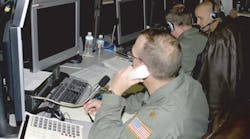By Courtney E. Howard
RESEARCH TRIANGLE PARK, N.C. - Officials of Semiconductor Research Corp. (SRC), a university-research consortium for semiconductors and related technologies in Research Triangle Park, N.C., say they have significantly extended Moore’s Law with insulators containing the exotic metal hafnium.
“The implications of hafnium-based insulators for the global chip business are revolutionary and have been heralded as the most promising advancements since the introduction of copper interconnect,” says Larry Sumney, president and chief executive officer of the SRC.
Moore’s Law, as stated by Intel founder Gordon Moore, holds that semiconductor functionality doubles every 18 months at no increase in price.
“Dedicated teamwork among several universities and industry has moved decades of research into the mainstream, resulting in the first announcements of planned commercial applications of hafnium-based insulators,” Sumney says.
In fact, chip-company executives have identified hafnium-based insulators, which will replace widely used silicon dioxide in semiconductors, as instrumental to their planned breakthroughs for small, powerful semiconductors.
Hafnium-based insulator technology enables an improved layer of material that regulates the flow of electricity through the more than 2 billion transistors used in today’s semiconductors. SRC-funded research, spanning more than a decade, set the groundwork for the electronics industry to implement these insulators in the manufacture of at least three more generations of chips, down to 22 nanometers (nm). The 22 nm chip generation is expected to go into production by 2016.
The benefits of the new technique include the ability to shrink transistors and potentially double their count on a chip, accelerate speed by more than 20 percent, reduce power leakage by as much as 80 percent, and halve power consumption.
“Just when the industry was hardest pressed to predict the next answers to the challenges facing the continued progress of the semiconductor, hafnium is brought to the rescue,” observes Bob Wallace, professor of electrical engineering and physics at the University of Texas at Dallas. “This is a great milestone,” says Wallace, who has worked with hafnium since the mid 1990s to overcome barriers to producing smaller chips.
SRC’s research network spans 23 companies and partners, in addition to 100 universities worldwide. Hundreds of university researchers participated in a collaborative effort that included The University of Texas, North Carolina State, U.C. Berkeley, U.C. Santa Barbara, University of Minnesota, Penn State, Yale, Rutgers, and others. SRC drives long-term semiconductor research contracts on behalf of its participating members: Advanced Micro Devices Inc., Applied Materials Inc., Axcelis Technologies Inc., Cadence Design Systems, Freescale Semiconductor Inc., Hewlett-Packard Co., IBM Corp., Intel Corp., LSI Logic Corp., Mentor Graphics Corp., The Mitre Corp., Novellus Systems Inc., Rohm and Haas Electronic Materials, Texas Instruments Corp., and Tokyo Electron Ltd. SRC also seeks to leverage funding from global government agencies.
More information about SRC is offered online at www.src.org.


